
Wine Culture and Information since 2002 - Volume 22
 Wine Culture and Information since 2002 - Volume 22 |
|
Issue 230, Summer 2023 |
Contents |
|
|
Organic Vineyards of France: an Unexpected Decline |
|
The cultivation of a vineyard or any other type of crop is dictated by the ethical and ideological sense of the farmer, adopting the method he or she believes to be the most suitable one for his or her own vision and coherent with the personal idea of the environment – last but not least – capable of allowing the production of healthy food or beverages for consumers, while ensuring profit. Anyone who cultivates land using organic farming therefore believes they are acting according to healthier criteria, both for the environment and for the consumer. To achieve this goal, shared and defined protocols are followed – either one's own, according to the personal vision or that of an association or controlling institution – generally limiting or excluding the use of substances which are considered unhealthy and harmful to man and the environment. Adopting the cultivation according to organic farming does not mean giving up the use of chemical products; rather make use of substances, even chemicals, which are considered respectful and healthy, especially within certain formulations and quantities. It is not my intention – of course – to specifically deal with the purpose and effects, including negative ones, of the chemical substances used in viticulture, whether conventional or organic. Nor is it my intention to try to support or denigrate one or the other cultural philosophy, as, very often, there is the risk of causing useless ideological and thought clashes. What I can instead testify – in about thirty years spent in the world of wine, also by tasting, by now, several tens of thousands of glasses – is that organic viticulture has followed exactly the cycle of any other “fad” about wine. As such, it had an explosive start – and I'm talking about the mid-1990s – followed by a relative “stasis”, therefore falling within the consensus of consumers, producers included, then going back up again with a decisive impetus, finally returning to the “equilibrium” phase. All of this – like any other fad – has also created supporters and opponents of organic wine (and not only that), both in consumers and producers. By considering what is happening across the Alps – in France – organic viticulture is perhaps going through a new period of “indifference”. According to the data released by Agence Bio – the French agency for the development and promotion of organic farming – in the document “Les chiffres du Bio Panorama 2O22” (The figures of the Bio panorama 2022), the last year in France there was a marked drop in the number of vineyards registered for conversion to organic farming compared to 2021. In fact, 2022 saw a sudden drop in the conversion of French vineyards to organic farming, after a long period of growth which seemed to be unstoppable. Data released by Agence Bio indicate that, in 2022, only 13,000 hectares of vineyards were registered for conversion to organic farming. A drop that marks -48% compared to 2021, when 24,800 hectares of vineyards were registered instead. Despite the decrease in registrations in 2022 compared to 2021, the total area of vineyards cultivated with organic farming has however increased by 5%. According to what was released by Agence Bio, this would be a signal that should not be underestimated, despite the fact it is – in overall terms – consistent with the current market trend of all the agricultural and food supply chains certified as organic. One of the causes which determined the current condition is to be traced back to excess production, such as to represent a consistent difficulty for the market of organic and bulk wines. In 2022, in fact, the sale of organic products in French supermarkets suffered a drop of -5%, while in shops specializing in organic farming products there was an even more substantial drop of -9%. In determining these negative results, wine – of course – represents an important share, both for the French domestic market and for exports. According to what was released by Agence Bio, wines from organic farming represent – alone – 39% of the overall export, for an economic volume of 565 million euros. This figure is in any case a positive sign as it marks an increase of +2% compared to 2021. As regards the French domestic market, the sale of wines from organic farming – despite the negative influence of current inflation – grew by +5%, equal to 1.4 billion euro. This result is nonetheless significant, in particular by considering the drop recorded in large-scale distribution (-7%, equal to 134 million euro) and shops specializing in organic products (-7%, equal to 55 million euro). The sectors which recorded a growth were those of direct sales (+5%, equal to 421 million euros), winery networks (+8%, equal to 159 million euros) and catering (+12%, equal to 129 million euros). Overall, 21% of France's vineyards are cultivated in organic agriculture – recognized by the relative certification – of which one third are in the conversion phase. The territory of France in which is recorded the largest share of vineyards cultivated in organic farming is Bordeaux, in particular the Gironde, with a total of 27,200 hectares, half of which in the process of conversion, where are being produced 31% of the total organic wines in France. Another territory of primary importance is Languedoc-Roussillon, in addition to the Rhone Valley which makes up 21% of the entire surface. In this regard, Henri Cozyns – president of the Vignerons Bio of Nouvelle-Aquitaine, the first territory in France for the surface area of vineyards under conversion – underlined the role and figure of the “organic winemaker”, defined as «the one who “pampers” biodiversity, safeguards natural resources, innovates with unique wines, without sulfur and other additions, participating in the local network. A winemaker who employs almost twice as many workers and does not disappoint, the one you would like to have as a neighbor». If the French organic wine market is experiencing a moment of difficulty, that of bulk wine is even considered “moribund”. And this, long before organic wine became an important element in the wine economy of France. In this regard, many are wondering about the real usefulness and necessity of bulk wine today, not only because of the fact in France there is a clear decline in consumption, but above all because of the choice of preferring bottled quality wine. The French consumer – therefore – is more interested in the quality and pleasure of a good wine, even if this means paying a higher price. In this regard, it is very interesting what emerges from the study conducted by Sowine-Dynata, a French consultancy agency specialized in wine trade and communication. According to this study, wines sold at prices below 5 euros are purchased by 2% of consumers, while 19% opt for bottles between 5 and 10 euros. 55% of French consumers buy wines sold at prices between 11 and 20 euros, while 24% are interested in those with prices over 20 euros. According to this study, therefore, the French consumer wants to drink less, but when he or she decides to do so, prefers good, quality and healthy wine, despite the fact this may correspond to an increase in price. If this condition is not met, the French consumer completely ignores the wine offer in the shop and decides to buy beer or other alcoholic beverages. In truth, this behavior is not found in France only. Even in Italy, it seems, consumers are since quite a long time oriented towards consuming less wine, but when they decide to do so, they choose quality bottles, therefore willing to spend more. This attitude is found both among consumers who prefer the so-called organic wines, and those who are not primarily interested in this kind of wine. Regardless of the market trend of the so-called organic wines, it is probably the normal cycle of interest that consumers show towards certain products, not only a cultural fact, therefore, but also the fad of the moment. Organic or non-organic, at least as far as I am concerned, the important thing is always to adopt conscious consumption, in moderation, provided it is always of high quality. Antonello Biancalana
|
||||
Contrasts of Riviera del Garda Classico Groppello and Colli del Trasimeno GamayTwo lakes and two reds. Wines representing the main productions and typical winemaking of their respective territories, different in all respects. |
|
Italy is a country rich in rivers, waterways, seas and lakes. In each region of the country, within their territory, rivers flow into seas and lakes, or originate from the latter. Italy is, no less, a country rich in wines and grapes, among the main wine-producing countries in the world that can boast a diversity and ampelographic richness which is difficult to equal elsewhere. The lands surrounding the lakes – and waterways in general – are characterized by their “special” soils, very different from those found, for example, in plains, hills and mountains. The soils surrounding lakes are generally mostly sand and gravel, as well as – of course – clay. It is therefore decidedly more loose soils, characterized by a higher draining power, despite the water is however present in different ways, thanks to the position near the lake. This type of soil enormously affects agricultural cultivation, therefore also viticulture which – in our specific case – directly affects the enological and organoleptic characteristics of the wines. This month's tasting by contrast will examine two wines produced in territories near two Italian lakes, among the main ones in the country in terms of surface area. These are Lake Garda – the largest in Italy by surface area – and Trasimeno, the fourth largest lake in the country. Famous and primary tourist destinations of the belpaese, both lakes boast important agricultural and viticultural activities, with significant wine productions and which are – in both cases – recognized by the Italian quality system as a Denominazione d'Origine Controllata (Denomination of Controlled Origin, DOC), that is Garda, Riviera del Garda Classico and Colli del Trasimeno. In these denominations are produced wines with grapes considered typical in their respective territories and which we will examine in our tasting: Groppello for the Riviera del Garda Classico, Gamay for the Colli del Trasimeno.
|
|
Groppello is a red berried variety of very ancient origins, already known in ancient Roman times. It is a grape – and therefore a wine – today considered as a rarity, as it is mainly cultivated in Valtenesi, in the province of Brescia (Lombardy), on the slopes of the hills which slope down towards Lake Garda, in the territory of Riviera del Garda denomination. Groppello is also found in Veneto and Trentino, however the most significant and important production comes from the territory of the Garda area in Lombardy and Valtenesi, in which vineyards Groppello is to be considered as the most typical and representative grape. The wines produced with this grape are recognized by the Italian quality system as Denominazione d'Origina Controllata Garda and Riviera del Garda – including the sub-denomination Valtenesi – with mention of the grape and in the classical and classic reserve styles. Groppello takes its name from the dialect word grop or gropo, with the meaning of “knot” or “pine cone”, due to the compact shape of the bunch and its tightly packed berries. Groppello is actually the name by which are generically defined the members of the homonymous family, made up of Groppello Gentile, Groppello di Santo Stefano, Groppello di Mocasina and Groppello di Revo, the latter found in the province of Trento. Although the production disciplinary of the Riviera del Garda Classico Groppello provides for the use of the Gentile, Mocasina and Santo Stefano varieties, producers tend to favor the use of Groppello Gentile only, a variety which, undeniably, is capable of producing wines of higher value and interest. In this regard, it should be noted the production disciplinary provides for a minimum 85% of Groppello variety, while any complementary part may be represented by non-aromatic red berried varieties permitted for cultivation in Lombardy region. Riviera del Garda Classico Groppello is a fine and elegant wine, often produced for immediate consumption, in which are mainly perceived aromas of red pulp fruits and an elegant spicy character, sometimes herbaceous.
|
||||
|
The history of Gamay in Lake Trasimeno is actually the result of a long series of misunderstandings and confusions, not always accidental. In fact, it is good to clarify – from the very beginning – that the most important and significant red grape cultivated in the western side of Lake Trasimeno and known as Gamay, has nothing in common with the homonymous and real typical variety of Beaujolais, known as Gamay Noir à Jus Blanc. What is grown in Lake Trasimeno is actually Grenache Noir (Garnacha Tinta), but since the confusion has, so to speak, rather ancient and historical roots, today there is a tendency to call it Gamay del Trasimeno or Gamay Perugino. But it always remains Grenache Noir, that is the same grape known in Sardinia as Cannonau and in Veneto as Tai Rosso. The production of this wine – Colli del Trasimeno Gamay – is mainly done in the territory of Castiglione del Lago, on the western side of the lake, in the province of Perugia. It is believed the introduction of this grape in the Castiglione del Lago area took place in the early 1600s by Eleonora Alarcòn y Mendoza, wife of Duke Fulvio della Corgna, the powerful Perugian family who governed the marquisate and then the duchy of Castiglione del Lago. It evidently was Garnacha Tinta – among the most important red berried grapes of Spain – starting a series of misunderstandings and confusions, so much to call that grape after the French Gamay. Apparently, the newcomer to the Trasimeno area was initially cultivated and trained as “alberello” and, for this reason, renamed as “French vineyard”, one of the probable causes which originated the confusion regarding the name of the vine. The history of Gamay-Grenache del Trasimeno was subsequently consolidated by the settlement of Sardinian shepherds, which took place at the end of the 1800s, who, coming from the Maremma lands, brought with them the most typical red grape of Sardinia: Cannonau, that is the Grenache Noir and which was already present in the Trasimeno area and erroneously known as Gamay. The genetic investigations carried out a few years ago by the University of Perugia made it clear and allowed to establish with certainty that the grape known for centuries in Umbria as Gamay is actually Grenache Noir.
|
Let's proceed with the purchase of the two bottles which we will pour into the glasses of our tasting by contrast. In this regard, it should be noted that these two wines are characterized by rather limited productions, both in terms of quantity and territory. It is therefore advised to go to a well-stocked wine shop. As far as the choice is concerned, we will pay attention both to the composition and to the vinification procedures. In accordance with the respective production disciplinary, both Riviera del Garda Classico Groppello and Colli del Trasimeno Gamay require the use of primary grapes for a minimum of 85%. When choosing the two bottles, we will therefore make sure they are respectively produced with 100% Groppello and Gamay (Grenache Noir). We will also pay attention to wine making practices, by choosing two wines fermented and aged in inert containers, preferably steel tanks. The two wines, belonging to the most recent vintage available, are served in their respective tasting glasses at a temperature of 17 °C. (62 °F) We can start our tasting by contrast from the evaluation of the appearance of the two wines. The first one we examine is Riviera del Garda Classico Groppello. Let's tilt the glass over a white surface – a sheet of paper is enough – and observe the base, in order to evaluate color and transparency. Groppello does not have a high coloring power, therefore its wines tend to have a pale ruby red color, however with good intensity and brilliance. By placing an object in contrast between the glass and the white surface, we can detect a moderate transparency and the object is quite visible. Let's now pay our attention towards the opening of the glass, where the thickness of the wine becomes thin, therefore evaluating the nuance which shows a purplish red color. Let's move on to the evaluation of the appearance of Colli del Trasimeno Gamay and tilt its glass over the white surface. By observing the base of the glass, the color is decidedly more intense than the previous wine – here we can see an intense ruby red – and the transparency is evidently lower. The nuance of the Umbrian wine, observed at the edge of the wine towards the opening of the glass, confirms the base ruby red color. The olfactory profiles of Groppello and Grenache Noir – known in the area of Lake Trasimeno as Gamay – are distinguished by substantial and important differences. Both wines are characterized by sensations recalling flowers and fruits, some of which are common in both grapes. The wines produced with Groppello – therefore also those belonging to the Riviera del Garda Classico denomination – express aromas directly recalling violets and, sometimes, roses, whereas for the aromas belonging to the world of fruits, the most common ones are cherry, blueberry, plum, black cherry, raspberry and blackberry. Furthermore, in red wines produced with Groppello, can be sometimes perceived spicy sensations – often reminiscent of black pepper – as well as herbaceous hints. The profile of Grenache Noir, the grape curiously known in Trasimeno as Gamay, is quite different. In these wines violet is the main representative of the world of flowers, whereas for that of fruits, are mainly perceived those with dark pulp, such as black cherry, plum and blueberry. Let's continue our tasting by contrast and, just like in the previous phase, the first wine of which we will evaluate the olfactory profile is Riviera del Garda Classico Groppello. Let's hold the glass in vertical position and, without swirling, proceed with the first smell in order to appreciate the opening of the wine, that is its identifying aromas. From the glass are perceived sensations of violet and rose, followed by cherry, blueberry and raspberry. Let's now swirl the glass, in order to favor the development of the remaining olfactory qualities, then let's proceed with the second smell. The profile of Riviera del Garda Classico Groppello is completed with plum, blackberry and strawberry, as well as a pleasing sensation recalling black pepper and a hint of herbaceous scent which vaguely recalls cut grass. Let's now pass to the evaluation of the olfactory profile of Colli del Trasimeno Gamay and, by holding the glass in vertical position, without swirling, let's evaluate its opening. To the nose we can perceive aromas of black cherry, plum and blueberry, as well as the scent of violet. After having swirled the glass, the olfactory profile of the Umbrian wine is completed by black currant, blackberry and raspberry. Let's now proceed with the evaluation of the gustatory profiles of our wines, starting – also in this case – from the Riviera del Garda Classico Groppello. Let's take a sip of the Lombard wine, an operation which allows the evaluation of the attack, that is the examination of its primary gustatory sensations. In the mouth is immediately perceived its direct and immediate character, with a sensation of moderate astringency as well as the pleasing crispness given by acidity, reaching balance with the effect of alcohol which, in this wine, is generally present in moderate quantity. In the mouth we perceive flavors of cherry, blueberry and raspberry, as well as a not excessive structure. Let's now pass to the evaluation of Colli del Trasimeno Gamay, then take a sip and evaluate its attack. In the mouth we perceive a sensation of fuller structure than Groppello, as well as a more intense astringency and less pronounced crispness. In the Umbrian wine the effect of alcohol is generally warmer than in Lombardy wine. In the mouth we perceive the flavors of black cherry, plum and blueberry. We have reached the end of our tasting by contrast, therefore we are going to evaluate the final sensations the two wines leave in the mouth, in particular the taste-olfactory persistence. The finish of Riviera del Garda Classico Groppello is persistent and in the mouth we continue to perceive its immediate character, as well as the moderate sensation of astringency and the pleasing crispness of acidity. Moreover, in the mouth are still clearly perceived the flavors of cherry, blueberry and raspberry, as well as a slightly bitter and spicy sensation, in which black pepper can be recognized. The finish of Colli del Trasimeno Gamay is equally persistent and in the mouth is perceived a sensation of fuller structure than the Lombard wine, as well as weaker crispness and a more accentuated roundness. We can continue to perceive the flavors of black cherry, plum, blueberry and blackberry. Before concluding the tasting, let's place the two glasses side by side and proceed with the last smell. The differences are still evident and note, in particular, the spicy and herbaceous characters of the Riviera del Garda Classico Groppello, completely absent in the Colli del Trasimeno Gamay.
|
||||||||
Wines of the Month |
|
|
|
Score legend Prices are to be considered as indicative. Prices may vary according to the country or the shop where wines are bought |
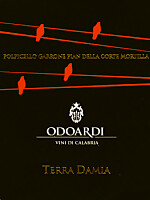
|
|
Terra Damia 2016 |
|
| Odoardi (Calabria, Italy) | |
 Gaglioppo, Magliocco, Nerello Cappuccio, Greco Nero Gaglioppo, Magliocco, Nerello Cappuccio, Greco Nero | |
| Price: € 14.00 | Score: |
 Intense ruby red and nuances of garnet red, little transparency. Intense ruby red and nuances of garnet red, little transparency. Intense, clean, pleasing, refined and elegant, starts with hints of
plum, black cherry and blackberry followed by aromas of dried violet,
carob, cocoa, tobacco, rhubarb, toffee, mace, licorice, cinnamon, vanilla
and menthol. Intense, clean, pleasing, refined and elegant, starts with hints of
plum, black cherry and blackberry followed by aromas of dried violet,
carob, cocoa, tobacco, rhubarb, toffee, mace, licorice, cinnamon, vanilla
and menthol.
 Properly tannic attack and however balanced by alcohol, good body,
intense flavors, pleasing roundness. Properly tannic attack and however balanced by alcohol, good body,
intense flavors, pleasing roundness.
 Persistent finish with flavors of plum, black cherry and blackberry. Persistent finish with flavors of plum, black cherry and blackberry. Aged in barrique and steel tanks. Aged in barrique and steel tanks. |
|
 Stuffed pasta with meat and mushrooms, Roasted meat, Stewed meat with mushrooms, Broiled meat and barbecue, Cheese Stuffed pasta with meat and mushrooms, Roasted meat, Stewed meat with mushrooms, Broiled meat and barbecue, Cheese |
|
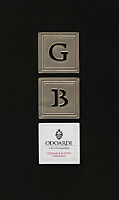
|
|
GB 2015 |
|
| Odoardi (Calabria, Italy) | |
 Gaglioppo, Magliocco, Nerello Cappuccio, Greco Nero Gaglioppo, Magliocco, Nerello Cappuccio, Greco Nero | |
| Price: € 35.00 | Score: |
 Deep ruby red and nuances of garnet red, little transparency. Deep ruby red and nuances of garnet red, little transparency. Intense, clean, pleasing, refined and elegant, starts with hints of
plum, black cherry and dried violet followed by aromas of blackberry,
blueberry, tobacco, carob, cocoa, licorice, coffee, leather, mace,
undergrowth, graphite, vanilla and menthol. Intense, clean, pleasing, refined and elegant, starts with hints of
plum, black cherry and dried violet followed by aromas of blackberry,
blueberry, tobacco, carob, cocoa, licorice, coffee, leather, mace,
undergrowth, graphite, vanilla and menthol.
 Properly tannic attack and however balanced by alcohol, full body,
intense flavors, pleasing roundness. Properly tannic attack and however balanced by alcohol, full body,
intense flavors, pleasing roundness.
 Very persistent finish with long flavors of plum, black cherry and
blackberry. Very persistent finish with long flavors of plum, black cherry and
blackberry.
 12 months in barrique, 6 months in bottle. 12 months in barrique, 6 months in bottle. |
|
 Game, Roasted meat, Stewed and braised meat, Hard cheese Game, Roasted meat, Stewed and braised meat, Hard cheese |
|
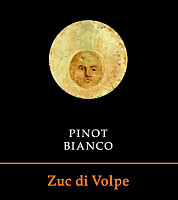
|
|
Friuli Colli Orientali Pinot Bianco Zuc di Volpe 2020 |
|
| Volpe Pasini (Friuli-Venezia Giulia, Italy) | |
 Pinot Bianco Pinot Bianco | |
| Price: € 22.00 | Score: |
 Brilliant straw yellow and nuances of straw yellow, very transparent. Brilliant straw yellow and nuances of straw yellow, very transparent. Intense, clean, pleasing, refined and elegant, starts with hints of
apple, peach and plum followed by aromas of white rose, chamomile,
hawthorn, broom, grapefruit, pear, lemon and pineapple. Intense, clean, pleasing, refined and elegant, starts with hints of
apple, peach and plum followed by aromas of white rose, chamomile,
hawthorn, broom, grapefruit, pear, lemon and pineapple.
 Crisp attack and however balanced by alcohol, good body, intense
flavors, agreeable. Crisp attack and however balanced by alcohol, good body, intense
flavors, agreeable.
 Persistent finish with flavors of apple, peach and plum. Persistent finish with flavors of apple, peach and plum. Aged in steel tanks. Aged in steel tanks. |
|
 Pasta with fish and crustaceans, Sauteed fish, Sauteed white meat, Fried fish, Dairy products Pasta with fish and crustaceans, Sauteed fish, Sauteed white meat, Fried fish, Dairy products |
|
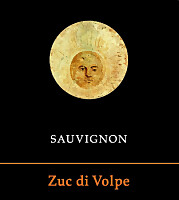
|
|
Friuli Colli Orientali Sauvignon Zuc di Volpe 2021 |
|
| Volpe Pasini (Friuli-Venezia Giulia, Italy) | |
 Sauvignon Blanc Sauvignon Blanc | |
| Price: € 22.00 | Score: |
 Intense greenish yellow and nuances of greenish yellow, very
transparent. Intense greenish yellow and nuances of greenish yellow, very
transparent.
 Intense, clean, pleasing, refined and elegant, starts with hints of
gooseberry, peach and bell pepper followed by aromas of elder flower,
broom, pineapple, citron, apple, pear, grapefruit, nettle, plum, box flower,
tomato leaf, sage and flint. Intense, clean, pleasing, refined and elegant, starts with hints of
gooseberry, peach and bell pepper followed by aromas of elder flower,
broom, pineapple, citron, apple, pear, grapefruit, nettle, plum, box flower,
tomato leaf, sage and flint.
 Crisp attack and however balanced by alcohol, good body, intense
flavors, agreeable. Crisp attack and however balanced by alcohol, good body, intense
flavors, agreeable.
 Very persistent finish with long flavors of gooseberry, pineapple and
citron. Very persistent finish with long flavors of gooseberry, pineapple and
citron.
 Aged in steel tanks. Aged in steel tanks. |
|
 Crustacean appetizers, Fried fish, Risotto with crustaceans and vegetables, Dairy products Crustacean appetizers, Fried fish, Risotto with crustaceans and vegetables, Dairy products |
|
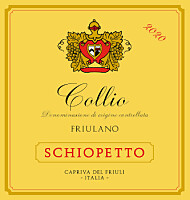
|
|
Collio Friulano 2020 |
|
| Schiopetto (Friuli-Venezia Giulia, Italy) | |
 Friulano Friulano | |
| Price: € 22.00 | Score: |
 Brilliant straw yellow and nuances of straw yellow, very transparent. Brilliant straw yellow and nuances of straw yellow, very transparent. Intense, clean, pleasing, refined and elegant, starts with hints of
apple, plum and hawthorn followed by aromas of broom, citrus fruits,
almond, pineapple, peach, medlar, pineapple and mineral. Intense, clean, pleasing, refined and elegant, starts with hints of
apple, plum and hawthorn followed by aromas of broom, citrus fruits,
almond, pineapple, peach, medlar, pineapple and mineral.
 Crisp attack and however balanced by alcohol, good body, intense
flavors, agreeable. Crisp attack and however balanced by alcohol, good body, intense
flavors, agreeable.
 Persistent finish with flavors of apple, plum and almond. Persistent finish with flavors of apple, plum and almond. 8 months in steel tanks, at least 5 months in bottle. 8 months in steel tanks, at least 5 months in bottle. |
|
 Pasta and risotto with fish, Stewed fish, Sauteed white meat, Vegetable flans, Dairy products Pasta and risotto with fish, Stewed fish, Sauteed white meat, Vegetable flans, Dairy products |
|
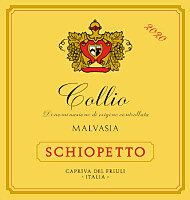
|
|
Collio Malvasia 2020 |
|
| Schiopetto (Friuli-Venezia Giulia, Italy) | |
 Malvasia Istriana Malvasia Istriana | |
| Price: € 22.00 | Score: |
 Intense straw yellow and nuances of straw yellow, very transparent. Intense straw yellow and nuances of straw yellow, very transparent. Intense, clean, pleasing, refined and elegant, starts with hints of
apple, pear and plum followed by aromas of chamomile, hawthorn, broom,
almond, peach, citrus fruits, pineapple, honey and mint. Intense, clean, pleasing, refined and elegant, starts with hints of
apple, pear and plum followed by aromas of chamomile, hawthorn, broom,
almond, peach, citrus fruits, pineapple, honey and mint.
 Crisp attack and however balanced by alcohol, good body, intense
flavors, agreeable. Crisp attack and however balanced by alcohol, good body, intense
flavors, agreeable.
 Persistent finish with flavors of apple, plum and almond. Persistent finish with flavors of apple, plum and almond. 8 months in steel tanks, at least 5 months in bottle. 8 months in steel tanks, at least 5 months in bottle. |
|
 Fish and crustacean appetizers, Pasta with fish and crustaceans, Sauteed fish Fish and crustacean appetizers, Pasta with fish and crustaceans, Sauteed fish |
|
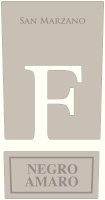
|
|
Negroamaro F 2020 |
|
| San Marzano (Apulia, Italy) | |
 Negroamaro Negroamaro | |
| Price: € 24.90 | Score: |
 Deep ruby red and nuances of garnet red, little transparency. Deep ruby red and nuances of garnet red, little transparency. Intense, clean, pleasing, refined and elegant, starts with hints of
black cherry, plum and blackberry followed by aromas of violet, blueberry,
tamarind, carob, chocolate, tobacco, mace, vanilla and menthol. Intense, clean, pleasing, refined and elegant, starts with hints of
black cherry, plum and blackberry followed by aromas of violet, blueberry,
tamarind, carob, chocolate, tobacco, mace, vanilla and menthol.
 Properly tannic attack and however balanced by alcohol, good body,
intense flavors, pleasing roundness. Properly tannic attack and however balanced by alcohol, good body,
intense flavors, pleasing roundness.
 Persistent finish with flavors of black cherry, plum and blackberry. Persistent finish with flavors of black cherry, plum and blackberry. 12 months in barrique. 12 months in barrique. |
|
 Stuffed pasta with meat and mushrooms, Broiled meat and barbecue, Stewed meat with mushrooms, Roasted meat, Cheese Stuffed pasta with meat and mushrooms, Broiled meat and barbecue, Stewed meat with mushrooms, Roasted meat, Cheese |
|
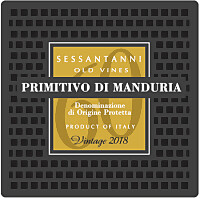
|
|
Primitivo di Manduria Sessantanni 2018 |
|
| San Marzano (Apulia, Italy) | |
 Primitivo Primitivo | |
| Price: € 26.90 | Score: |
 Deep ruby red and nuances of garnet red, little transparency. Deep ruby red and nuances of garnet red, little transparency. Intense, clean, pleasing, refined and elegant, starts with hints of
plum, black cherry and blackberry followed by aromas of violet, carob,
blueberry, tobacco, chocolate, tamarind, cinnamon, leather, pink pepper,
mace, vanilla and menthol. Intense, clean, pleasing, refined and elegant, starts with hints of
plum, black cherry and blackberry followed by aromas of violet, carob,
blueberry, tobacco, chocolate, tamarind, cinnamon, leather, pink pepper,
mace, vanilla and menthol.
 Properly tannic attack and however balanced by alcohol, full body,
intense flavors, pleasing roundness. Properly tannic attack and however balanced by alcohol, full body,
intense flavors, pleasing roundness.
 Very persistent finish with long flavors of plum, black cherry and
blackberry. Very persistent finish with long flavors of plum, black cherry and
blackberry.
 At least 12 months in barrique. At least 12 months in barrique. |
|
 Game, Roasted meat, Braised and stewed meat, Hard cheese Game, Roasted meat, Braised and stewed meat, Hard cheese |
|
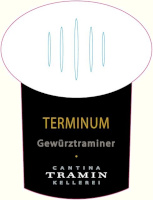
|
|
Alto Adige Gewürztraminer Terminum 2021 |
|
| Cantina Tramin (Alto Adige, Italy) | |
 Gewürztraminer Gewürztraminer | |
| Price: € 43.00 - 375ml | Score: |
 Brilliant golden yellow and nuances of golden yellow, very transparent. Brilliant golden yellow and nuances of golden yellow, very transparent. Intense, clean, pleasing, refined and elegant, starts with hints of
grape, apricot and white rose followed by aromas of carnation, lavender,
mango, lychee, pineapple, apple, pear, peach, citrus fruit peel, ginger,
saffron, honey, candied fruits, cinnamon and hints of vanilla. Intense, clean, pleasing, refined and elegant, starts with hints of
grape, apricot and white rose followed by aromas of carnation, lavender,
mango, lychee, pineapple, apple, pear, peach, citrus fruit peel, ginger,
saffron, honey, candied fruits, cinnamon and hints of vanilla.
 Sweet and round attack, however balanced by alcohol, good body, intense
flavors, pleasing crispness. Sweet and round attack, however balanced by alcohol, good body, intense
flavors, pleasing crispness.
 Very persistent finish with long flavors of grape, apricot and mango. Very persistent finish with long flavors of grape, apricot and mango. 12 months in barrique, 9 months in steel tanks. 12 months in barrique, 9 months in steel tanks. |
|
 Jam and dried fruit tarts, Hard and piquant cheese Jam and dried fruit tarts, Hard and piquant cheese |
|
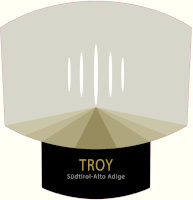
|
|
Alto Adige Chardonnay Riserva Troy 2019 |
|
| Cantina Tramin (Alto Adige, Italy) | |
 Chardonnay Chardonnay | |
| Price: € 75.00 | Score: |
 Brilliant straw yellow and nuances of straw yellow, very transparent. Brilliant straw yellow and nuances of straw yellow, very transparent. Intense, clean, pleasing, refined and elegant, starts with hints of
banana, apple and acacia followed by aromas of chamomile, papaya,
pineapple, mango, pear, grapefruit, plum, praline, honey, almond,
hazelnut, butter, mineral and hints of vanilla. Intense, clean, pleasing, refined and elegant, starts with hints of
banana, apple and acacia followed by aromas of chamomile, papaya,
pineapple, mango, pear, grapefruit, plum, praline, honey, almond,
hazelnut, butter, mineral and hints of vanilla.
 Crisp attack and however balanced by alcohol, good body, intense
flavors, pleasing roundness. Crisp attack and however balanced by alcohol, good body, intense
flavors, pleasing roundness.
 Very persistent finish with long flavors of apple, banana e papaya. Very persistent finish with long flavors of apple, banana e papaya. Fermented in barrique. 12 months in barrique, 22 months in stll tanks,
4 months in bottle. Fermented in barrique. 12 months in barrique, 22 months in stll tanks,
4 months in bottle.
|
|
 Pasta and risotto with fish and crustaceans, Stewed fish, Stewed white meat, Vegetable flans, Dairy products Pasta and risotto with fish and crustaceans, Stewed fish, Stewed white meat, Vegetable flans, Dairy products |
|
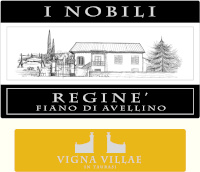
|
|
Fiano di Avellino Reginè 2021 |
|
| Vigna Villae (Campania, Italy) | |
 Fiano Fiano | |
| Price: € 18.00 | Score: |
 Brilliant golden yellow and nuances of golden yellow, very
transparent. Brilliant golden yellow and nuances of golden yellow, very
transparent.
 Intense, clean, pleasing and refined, starts with hints of apple, pear
and plum followed by aromas of hawthorn, broom, citrus fruits, pineapple
and hazelnut. Intense, clean, pleasing and refined, starts with hints of apple, pear
and plum followed by aromas of hawthorn, broom, citrus fruits, pineapple
and hazelnut.
 Crisp attack and however balanced by alcohol, good body, intense
flavors, agreeable. Crisp attack and however balanced by alcohol, good body, intense
flavors, agreeable.
 Persistent finish with flavors of apple, pear and plum. Persistent finish with flavors of apple, pear and plum. Aged in steel tanks. Aged in steel tanks. |
|
 Fish and vegetable appetizers, Risotto with crustaceans and vegetables, Sauteed fish, Dairy products, Eggs Fish and vegetable appetizers, Risotto with crustaceans and vegetables, Sauteed fish, Dairy products, Eggs |
|
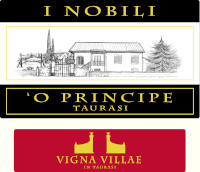
|
|
Taurasi O' Principe 2007 |
|
| Vigna Villae (Campania, Italy) | |
 Aglianico Aglianico | |
| Price: € 47.00 | Score: |
 Intense ruby red and nuances of garnet red, little transparency. Intense ruby red and nuances of garnet red, little transparency. Intense, clean, pleasing, refined and elegant, starts with hints of
plum, blackberry and dried violet followed by aromas of black cherry,
blueberry, cocoa, tobacco, carob, leather, cinnamon, licorice, vanilla and
menthol. Intense, clean, pleasing, refined and elegant, starts with hints of
plum, blackberry and dried violet followed by aromas of black cherry,
blueberry, cocoa, tobacco, carob, leather, cinnamon, licorice, vanilla and
menthol.
 Properly tannic attack and however balanced by alcohol, good body,
intense flavors, pleasing crispness. Properly tannic attack and however balanced by alcohol, good body,
intense flavors, pleasing crispness.
 Persistent finish with flavors of plum, blackberry and black cherry. Persistent finish with flavors of plum, blackberry and black cherry. 42 months in barrique. 42 months in barrique. |
|
 Stuffed pasta with meat and mushrooms, Roasted meat, Stewed meat with mushrooms, Cheese Stuffed pasta with meat and mushrooms, Roasted meat, Stewed meat with mushrooms, Cheese |
|

|
|
Morellino di Scansano Riserva 2019 |
|
| Moris Farms (Tuscany, Italy) | |
 Sangiovese (90%), Cabernet Sauvignon, Merlot (10%) Sangiovese (90%), Cabernet Sauvignon, Merlot (10%) | |
| Price: € 20.50 | Score: |
 Intense ruby red and nuances of garnet red, little transparency. Intense ruby red and nuances of garnet red, little transparency. Intense, clean, pleasing and refined, starts with hints of black
cherry, plum and geranium followed by aromas of violet, blueberry,
blackberry, chocolate, tobacco, mace, vanilla and menthol. Intense, clean, pleasing and refined, starts with hints of black
cherry, plum and geranium followed by aromas of violet, blueberry,
blackberry, chocolate, tobacco, mace, vanilla and menthol.
 Properly tannic attack and however balanced by alcohol, good body,
intense flavors, agreeable. Properly tannic attack and however balanced by alcohol, good body,
intense flavors, agreeable.
 Persistent finish with flavors of black cherry, plum and blueberry. Persistent finish with flavors of black cherry, plum and blueberry. 12 months in barrique, at least 6 months in bottle. 12 months in barrique, at least 6 months in bottle. |
|
 Broiled meat and barbecue, Roasted meat, Stewed and braised meat with mushrooms, Hard cheese Broiled meat and barbecue, Roasted meat, Stewed and braised meat with mushrooms, Hard cheese |
|
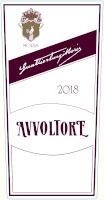
|
|
Avvoltore 2018 |
|
| Moris Farms (Tuscany, Italy) | |
 Sangiovese (75%), Cabernet Sauvignon (20%), Syrah (5%) Sangiovese (75%), Cabernet Sauvignon (20%), Syrah (5%) | |
| Price: € 35.00 | Score: |
 Intense ruby red and nuances of garnet red, little transparency. Intense ruby red and nuances of garnet red, little transparency. Intense, clean, pleasing, refined and elegant, starts with hints of
black cherry, plum and black currant followed by aromas of dried violet,
dried rose, carnation, peony, blueberry, blackberry, chocolate, tobacco,
cinnamon, mace, vanilla and menthol. Intense, clean, pleasing, refined and elegant, starts with hints of
black cherry, plum and black currant followed by aromas of dried violet,
dried rose, carnation, peony, blueberry, blackberry, chocolate, tobacco,
cinnamon, mace, vanilla and menthol.
 Properly tannic attack and however balanced by alcohol, full body,
intense flavors, agreeable. Properly tannic attack and however balanced by alcohol, full body,
intense flavors, agreeable.
 Very persistent finish with long flavors of black cherry, plum and
black currant. Very persistent finish with long flavors of black cherry, plum and
black currant.
 12 months in barrique, 6 months in bottle. 12 months in barrique, 6 months in bottle. |
|
 Game, Roasted meat, Braised and stewed meat, Hard cheese Game, Roasted meat, Braised and stewed meat, Hard cheese |
|
News |
|
In this section are published news and information about events concerning the world of wine and food. Whoever is interested in publishing this kind of information can send us a mail to our address.
|
AquavitaeReview of Grappa, Distillates and Brandy |
|
|
||||||||||||
Wine Guide ParadeApril 2023
|
| |||||||
Privacy Policy | |||||||


| Copyright © 2002-2024 Antonello Biancalana, DiWineTaste - All rights reserved |
| All rights reserved under international copyright conventions. No part of this publication and of this WEB site may be
reproduced or utilized in any form or by any means, electronic or mechanical, without permission in writing from DiWineTaste. |